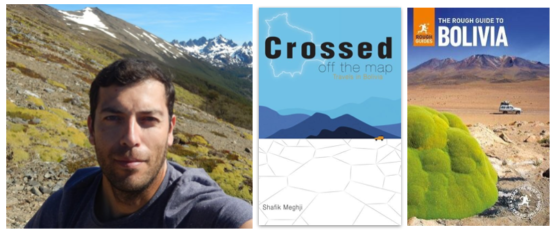Oct 05 2022 34 mins 16
From the silver mines of empire to lithium mining under gigantic salt flats, Bolivia has played a significant part in history and is now shaping the future of green technology. Shafik Meghji talks about the diversity of the country from its landscape to its people and religious ceremonies, as well as recommended places to visit, and books to read.
Shafik Meghji is an award-winning travel writer, journalist, and author, specializing in Latin America and South Asia. He has co-authored more than 40 guidebooks. His latest book is Crossed Off the Map: Travels in Bolivia.
Show notes
- Bolivia’s geographical diversity and recommended places to visit, including the largest salt flats in the world
- The unexpected ways Bolivia has influenced and shaped the world
- Indigenous culture and architecture
- Festivals and other religious and cultural events, including the dance of the devils and the witches’ market
- Balancing the desire to travel with environmental responsibility
- Recommended books about Bolivia
You can find Shafik Meghji at ShafikMeghji.com
Transcript of the interview
Joanna: Shafik Meghji is an award winning travel writer, journalist, and author, specializing in Latin America and South Asia. He has co-authored more than 40 guidebooks. His latest book is Crossed Off the Map: Travels in Bolivia. Welcome, Shafik.
Shafik: Thanks, Jo. It’s a pleasure to be chatting to you. Looking forward to talking about all things Bolivia.
Joanna: Let’s start with the basics, just in case people don’t know.
Where is Bolivia? And what are some of its unique characteristics in terms of geography and climate?
Shafik: Partly, as the title of my book alludes to, a lot of people who aren’t familiar with South America or Bolivia specifically, would find it difficult to place. It’s essentially right in the heart of South America. It’s bounded by five different countries; Brazil, and Argentina, Peru, Paraguay, and Chile.
It’s incredibly geographically and climatically diverse, so it’s landlocked, but apart from the sea, it has the world’s largest salt flat, it has massive payotes due to the Lake Titicaca, which I’m sure lots of people have heard of.
It has some of the highest mountains on earth, of course, the Andes, it’s got part of the Panama Canal, which is the world’s largest tropical wetland, which he shares with Brazil, around a third of it lies within the Amazon basin. There are foothills and there are low-lands. There’s desert-like landscapes, this huge metropolis, like cities is incredibly diverse, and the climate ranges from absolutely freezing to sweltering. And you can sometimes experience both of those in the same day.
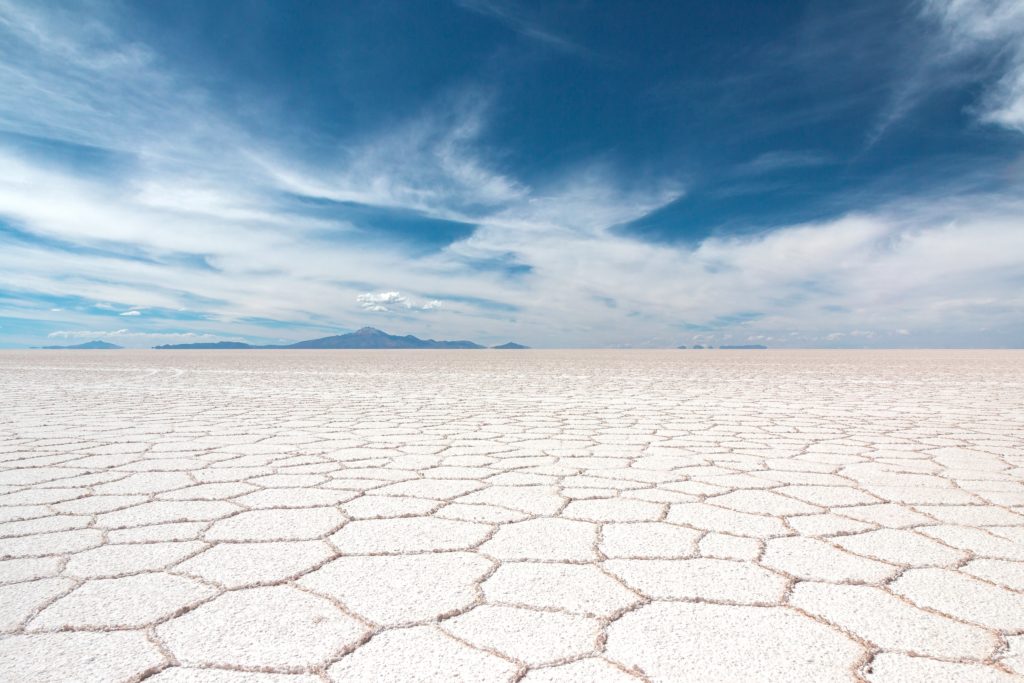
Joanna: How brilliant. We’re going to come back to some of these places.
How did you come to travel so much to Bolivia? And what’s your personal link there?
Shafik: I think like a lot of places and destinations that people come to love, it was really just by chance, it was a bit of an accident. I started off my career as a news desk sports journalist, and then slowly got fed up with that and resigned, and went backpacking around India, and then around South America.
I was really at that point, just in the highlights, I wanted to go to Rio for Carnival, and I had a wonderful time there.
Joanna: Of course.
Shafik: Of course, it’s impossible not to and really I only planned to spend a few weeks there and ended up spending a couple of months. But after that I’ve managed to drag myself away and I wanted to hike the Inca Trail to Machu Picchu, The Classic Gringo Trail stuff. But at the time I couldn’t afford to fly and the cheapest way was to travel overland from Brazil to Peru, through Bolivia. And so I planned to do that and didn’t really think too much about it.
I didn’t really know much about the country.
But as soon as I crossed the border, I got hooked, I ended up travelling to the Salar de Uyuni, an otherworldly landscape, the world’s largest salt flat. I visited the world’s richest silver mine, I traveled into the Amazon and explored the most biodiverse National Park on Earth. I went to some of the highest cities in the world, well over 4000 meters.
During that time, I really started to learn a bit more about the cultures, the peoples, the history, and I realized that this country that most people, including myself, before visiting would have had trouble placing on a map has actually influenced and helped even to shape the world in profound and unexpected ways. And that really led to kind of a lifelong love of the place.
So I later returned as a travel writer to co-author The Rough Guide to Bolivia. And that gave me a great excuse and an opportunity to visit virtually every part of the country. In doing so, I met so many fascinating people who were generous enough to share their stories. And I learned about the history of the country.
I learned about how, really, it feels like the future has arrived in Bolivia. It stands on the front line of so many touchstone issues, like climate, emergency, populism, and so on. And that all was brought together in my book Crossed Off the Map.
Joanna: I want to return something you said, that Bolivia has influenced and shaped the world in unexpected ways. I bet everyone’s listening is as surprised about that, because probably we don’t know.
What are some of the ways that Bolivia has shaped the world?
Shafik: I’ll tell you the story that really first gave me an insight into this aspect of Bolivia’s history, and it was a visit to a place called Potosi, which today most people outside the country don’t really know too much about it, may not have heard of it before.
Potosi is the second highest city on Earth. It’s high up in the Altiplano, which is a high plane between two branches of the Andes. It’s a city and above it, well, is a mountain called Cerro Rico and that was home about 500 years ago to the richest silver mine in history.
During the Spanish colonial period, so much silver was pulled out of these mines that they said that according to legend you could build a solid over railway track all the way from Bolivia to Madrid, and still have enough leftover for a solid silver engine divide on top.
This silver changed the world. It connected up Europe, and Latin America, and Africa, and Asia, together for the first time. The silver was shipped to Europe, which helped to fund the Industrial Revolution, and various wars and conflicts. It traveled over to Asia to Manila on these huge galleons. And there, it was traded for Chinese-made goods.
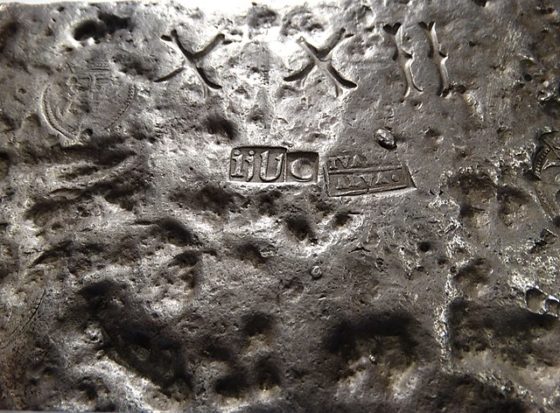
The silver from Potosi helped to fund the Great Wall of China, for example. And it also played a role in destabilizing various dynasties.
It became such a significant place for hundreds of years.
And it became synonymous with great wealth in ‘Don Quixote,’ there’s a phrase ‘worth a potosi,’ which means worth a fortune, which would have been commonly understood at that time, now is obviously drifted out. It’s also the source of that quirky things such as ‘pieces of eight’. This pirate phrase is actually based on some of the silver currency that came out of Potosi.
When I visited, I didn’t know anything about this. But I ended up going into these mines, which are centuries old, now they call them rat runs, they’re very claustrophobic and simultaneously thousands of meters above sea level, and hundreds of meters underground, and you’re crawling on your stomach. And then there’s all these poisonous dusts around.
There was arsenic dust everywhere when I visited. It’s a very unsettling place. And you see the miners who still work there now the silver has largely long gone. But many miners still work there hoping to strike it rich in very, very difficult conditions. It’s incredibly intense experience.
That started to give me an idea and an interest in the history. And then the more I read, and the more I learned, and the more I spoke to people in the city, I realized what an influence of this city, once on of the richest and biggest on Earth, but now forgotten, that had on the rest of the world.
It’s stories like that, that helped to spur me to write the book, because I thought these are just fantastic stories. And they deserve to be better known beyond Bolivia’s borders.
Joanna: Wow, that is so interesting. When you look into history, and you realize how far things travel, it’s incredible. What you’re talking about there is essentially pillaged out of Bolivia and taken across the world. I wonder how much of our silver that we look at here even in England is from there. I presume it doesn’t have a mark.
Once things are made into things we wouldn’t know, would we, how far the silver has gone?
Shafik: Absolutely. People listening to this podcast will have silver, they got old heirlooms, family heirlooms perhaps, or things that are made a few 100 years ago, they may well have something made from Potosi silver.
And I should say at this point that, of course, all of this wealth came at a great cost. It was borne by the indigenous peoples of the Andes.
And it was also born by enslaved Africans who were trafficked over to labor in the mines, and in the smelting plants and so on. But definitely Potosi silver, people will have seen it, and some people may have it in their possession without knowing it.
One other side kind of quirky thing from that is that the dollar sign one of the most recognizable symbols today, the origin of that also kind of drifts back to Potosi. Potosi’s initials, used to be stamped on the silver coins that were made in the Royal Mint, which is now a fascinating Museum in Potosi. And they were shipped around the world. The PTSI over one another vaguely resembles the dollar sign. And that was how that particular symbol developed.
Joanna: Wow. That’s so interesting. Coming back to the indigenous people, because the history of the world is a history of conquest. But there are I think, based on looking at your book, there are still aspects that the indigenous people still play a part in the culture.
What aspects of Bolivia now are based around the indigenous people?
Shafik: Well, this is one of the aspects of Bolivian society that really fascinates me and also, I think, is really of interest to the increasing numbers of travelers and tourists that make it out there.
Huge numbers of Bolivians have indigenous heritage. And there’s an incredible range of indigenous cultural groups across the country with often very different beliefs, and practices, and cultural makeups, and so on. And really, over the last 20 years or so, often many centuries of repression and violence and so on.
Some of those things are starting to be collected in Bolivia. Bolivia, about 20 years ago had the first indigenous president in South American history Juan Evo Morales. And although his legacy is mixed, shall we say, one of the things that it led to was a real flourishing of indigenous identity, and pride, and representation.
If you travel in Bolivia today, or any part of Bolivia, from the hot and sweaty east and low-lands, all the way up into the Amazon or to the high-altitude cities of the Andes, you will see indigenous culture thriving in a way that you may not see in many neighboring countries such as Chile, or Argentina, or Brazil.
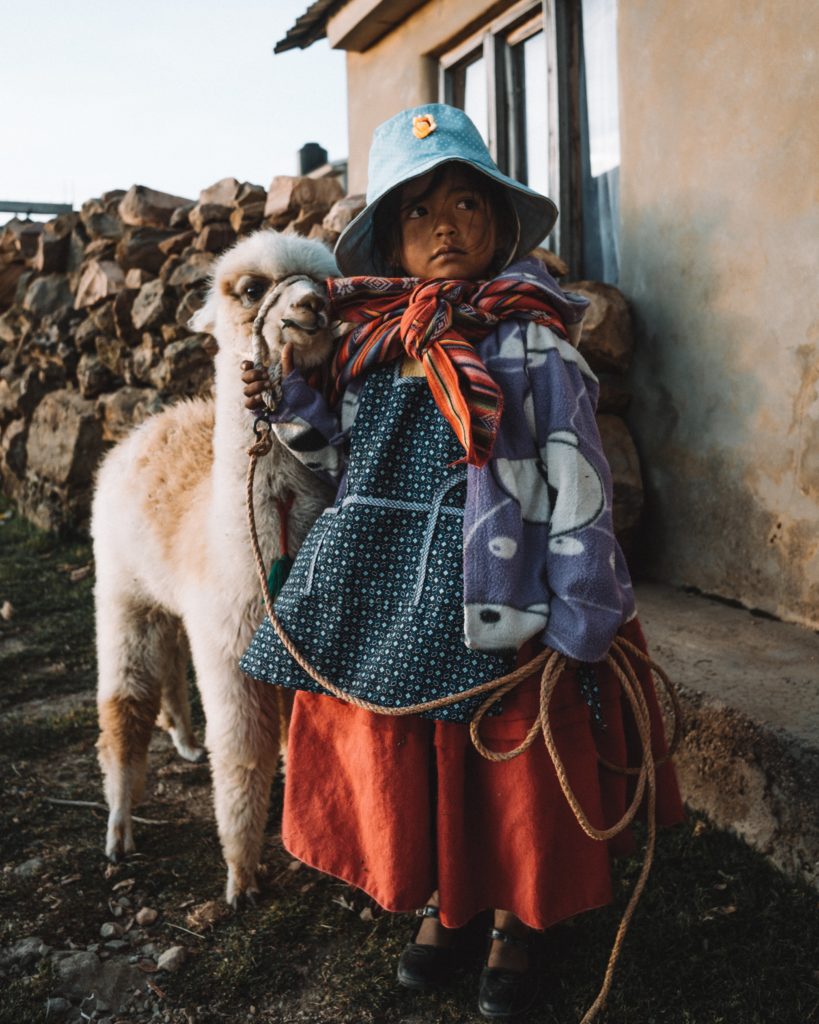
And of course, these indigenous cultures are fused with European influences. And also African influences, as I mentioned, huge numbers of enslaved Africans were trafficked to Bolivia, and elsewhere in South America, of course, during the colonial period. All of these are fused together.
I’m sure we’ll talk about some of the festivals and celebrations later in this talk, but you really see some of those, this fusion of ideas and this blend and this mixture of influences coming together in events like that.
Joanna: Tell us about these now. And you’ve mentioned that wherever you travel, you can find this.
Are there specific places that people can go to and attend one of these festivals or places where the architecture might be resonant?
Shafik: Absolutely. It’s always better to be specific with these kinds of things. I’ll pick a couple in terms of festivals and religious celebrations.
Carnival in Bolivia, and carnival’s celebrated across Bolivia. But the most famous one is in a city called Oruro, which is an old tin mining city in the Andean region, and it can be a kind of melancholy place for much of the year. But during Carnival, late February, early March, it becomes a riot of activity.
As I mentioned the celebrations blend indigenous African and European influences, their parades and street parties. The highlight is the Diablada, which is the dance of the devils. And essentially, that’s a snaking procession of dancers in devilish masks, clanging brass bands coming up behind them, and there is figures representing Lucifer and Archangel Michael, everyone’s in absolutely outlandish costumes.
Despite the Christian veneer behind things, you really see the indigenous origins of the beliefs coming to the fore. Lucifer, as is often said, to represent the Andean god of the underworld.
You can go along and as people might expect from carnivals around the world, there’s copious eating, and drinking, and dancing, and merrymaking, and so on. But the Oruro Carnival is an absolutely fascinating thing to really experience.
There’s lots of historic architecture. There are ruins dating back to pre-Inca civilizations, there’s lots and lots of Spanish colonial architecture in cities like Sucre.
But the architecture I’m often most interested in, is in a place called El Alto.
Now El Alto is not too familiar for people outside of South America is the highest city on Earth. It’s just above La Paz, which is the de facto capital. And it’s really it’s developed, it’s one of the fastest growing cities in South America. It’s developed massively over the last 40 years or so. Huge numbers of indigenous migration, predominantly people from the Aymara and indigenous group who have fled droughts and it’s often caused by the climate crisis, which is having a huge impact in the Andes, but also economic crises and political crises and so on.
They flocked to this city and it’s become a real hotbed of Aymara culture and identity. And one of the ways that you see this expressed is in the architecture, and over the last couple of decades, something called cholets have developed. These are multipurpose, incredibly colorful, bright buildings that double up as shops as entertainment spaces for weddings or birthday parties, and so on, which play a big role in Aymara culture, and there’s often some housing as well, and including for the owner, often a chalet, which is part of the portmanteau word.
But the look of these buildings is incredibly eye-catching. You’ll have some that resemble characters for Marvel movies, you’ll have some that represent…there’s one that has been designed to look like Optimus Prime, a character from transformers. They have Technicolor, lots of glass and mirrors and all manner of colors, and they blend both kind of modern touches with indigenous Andean symbols. It’s a real clash of influences.
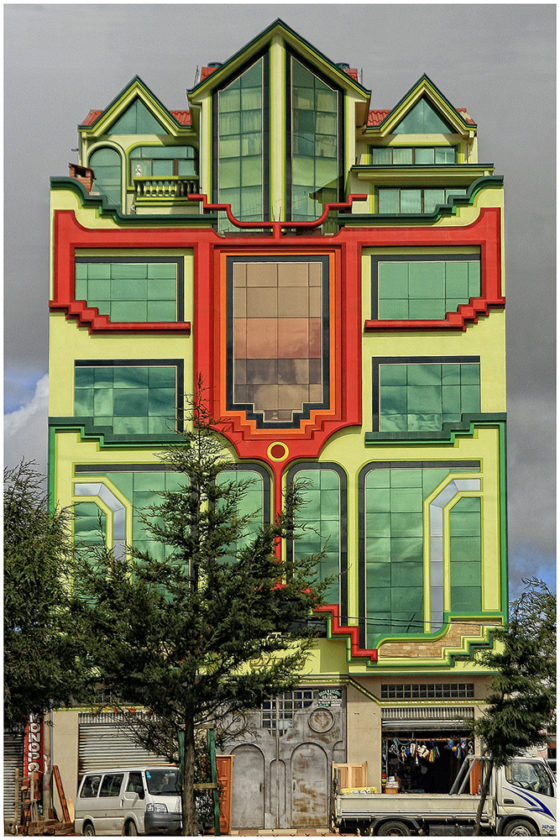
The last time I visited, I had a wonderful guide, and she described it as firecracker architecture. I certainly can’t do any better than that. But I really advise the audience to stick it into Google after you’ve listened to this and have a look, because they’re absolutely fascinating but also they’ve got a great story behind them, too.
Joanna: That’s great. I always like to find pictures for the show notes. So hopefully I’ll have some, if people want to go look at the show notes. But I want to come back, lots of things to come back on.
You mentioned this thin Christian veneer. I like that phrase a lot. When I was having a look at your book and about a cities that it seems that death culture and occult things are more common.
You mentioned the devil dancing, but La Paz has this unusual cemetery and there’s a witch market.
Tell us what is underneath this thin Christian veneer that you mentioned?
Shafik: It’s something that if you visit a city like La Paz, it’ll immediately become obvious to you just as you wander the streets.
Let’s start off with the cemetery. It’s the Cementerio General, the general cemetery, the biggest in La Paz. But essentially, it’s a mini city, I think it’s roughly about 1.5 square miles. So huge really, kind of dates back to the early 1800s. And they’re really compact, too. So they’re all stacked on top of each other, almost like shelves, and space is of an essence.
La Paz is in a valley high up in the mountains, very, very steep sides. But the buildings are absolutely crammed in there, there’s not a lot of space. So that’s reflected in something like the cemetery. I believe that remains had to be cremated after about 10 years and moved to a smaller space. So you’re often only temporarily in a slot in the cemetery. But if you walk round, it feels like you’re in a mini-city of the dead within the larger city of La Paz.
Actually, just to go very briefly off tangent, you’ll find this similar things in other South American cities, even in places like Buenos Aires, the famous Recoleta cemetery, huge, huge places, and they’re right in the middle of the cities. They’re more of an urban field than often our graveyards and cemeteries are, say in the UK.
But often when I’m traveling to research articles, or to collect books, I always pay a visit to the cemetery because I think they offer an incredible insight into the history, the place just the names, the causes of death and that kind of thing. It offers an insight into the culture and the history.
Something that’s much more on the tourist trail than that though, is the Witches’ Market, which is in the heart of the tourist, their backpacker area. And essentially, although it’s called the Witches’ Market, that’s actually a kind of a Spanish colonial term is women, predominantly indigenous women known locally as chifleras.
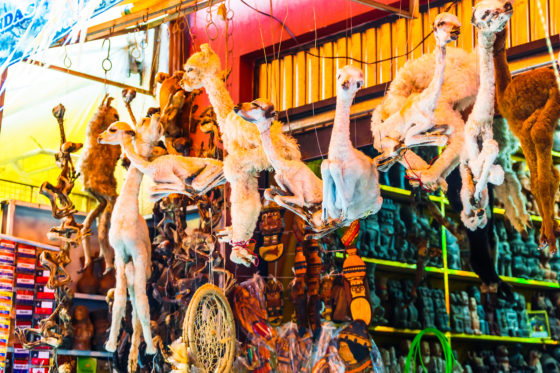
It’s a cross between a healer, a counselor, a doctor, a medicine woman, it doesn’t have the kind of the pejorative sense the witch is often used that for in an English language point of view. But their stalls are absolutely incredible to look around. Often they have all manner of amulets and potions and the thing that really strikes newcomers the most are the llama fetuses which are dried…
Joanna: Oh.
Shafik: …and, yeah, and hung up above the door. And you often have to duck under them to get into these tiny shops. And they’re really like almost as big as a broom cupboard is that kind of thing.
The Ilama fetuses feature very heavily in traditional central Andean traditions. For example, if you’re buying a new house, or you’re building a new house, you will often bury Ilama fetus beneath the surface, beneath the foundations, and that’s supposed to bring you luck.
Joanna: It’s like a rabbit’s foot here in the UK. People carry a rabbit’s foot for luck. We don’t now, but it’s one of these lucky charm type things.
Shafik: Exactly. And actually, it’s a really good example to bring up because often if you’re coming from UK, you come from Europe, this seems crazy and outlandish and ‘very exotic.’ But, actually, when you interrogate some of our own beliefs, often actually there are similarities with them.
I should say the llama fetuses are stillbirth, they’re stillborn. So that’s how they come about. Across the Andean part of Bolivia, you’ll see llamas and alpacas play a huge part in the culture both as food, and transport, and for cultural reasons.
The so called Witches’ Market rather, offers a fascinating insight into these beliefs which live in beliefs, really. And particularly if you speak some Spanish, then you can have a chat with some of the chiflera, who normally if you buy something, will be happy to talk.
Joanna: You mentioned that this so called Witches’ Market is in the tourist area, and you said earlier about The Gringo Trail and this backpacker route and it comes down to one of the difficulties that I think you do tackle in your book, which is that yes, we want to travel. We are people who like to travel. But there’s also the climate crisis that you mentioned. Are we changing culture through backpacking and all of this?
How can we balance this as people who want to travel but also want to be more responsible?
Shafik: I think this is a key question for really for travel writers, but all of us who travel and go on holiday at the moment. First of all, if you’re in the UK, you’ve got to fly to Bolivia, which obviously has a huge carbon imprint. Putting that to one side, there are lots of ways that while you’re there, that you can actually have a positive impact on local communities, and particularly local communities that are bearing the brunt of the climate crisis.
There are lots of really good community-run and indigenous-run tourism agencies. And also lodges give you a really good practical example, there’s a logical Chalalan, which is Parque Nacional Madidi Amazon, is run by an indigenous community. And it’s helped to both empower that community and also help to preserve some of the most biodiverse rainforest on Earth.
So I think if you’re there, there’s ways to have a positive impact. Obviously, try and avoid internal flights, as tempting as that can be. But also be aware that the way you spend your money, you’re obviously having an impact on the local cultures, as well.
The Witches’ Market, which obviously we’re just talking about, is aimed at local people, originally, but it has become more touristy in recent years. And you can generally see that some aspects of it are played up. It’s a difficult balancing act, because also tourists spending money is a key source of income for these people as well.
So I think, definitely look for independent places to stay in, look for locally and, ideally, indigenous-ran tourism organizations to go with travel agencies, and really try and minimize your carbon impact once you’re there, which is taking public transport, avoiding flights.
And also, if you visit reserves, not just in the Amazon, but also places like the Salar de Uyuni, which is the world’s largest salt flat, the tourism gives local people an economic incentive to help conserve these often very threatened ecosystems. So it’s a thorny issue, that there’s not easy answers to it. But there are certainly ways to minimize the negative impact you have, and in certain areas have a positive impact when you visit.
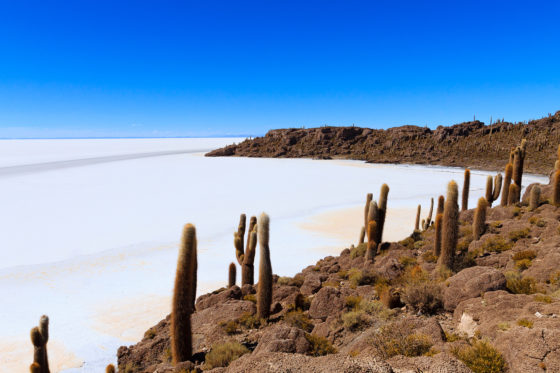
Joanna: You’ve mentioned this salt flat several times. And part of me is like, “Okay, that sounds great.” And then part of me just has this view in my mind that, “I would never want to visit a salt flat.”
What is it about this salt flat that makes it so amazing?
Shafik: On the surface, it doesn’t sound super appealing. But if you imagine an incredibly flat blindingly white, the brightest place I’ve ever been, expanse, surrounded by volcanoes, and mountains, and dotted with these islands of giant cacti. It’s a really otherworldly landscape. And I just said it’s the biggest in the world is roughly the size of Jamaica. That’s how big this salt flat is.
This is only one of several salt flats in southwestern Bolivia. But you can explore on detours and the surface of the salt flat, are covered by…they look like giant fish scales, kind of hexagonal shapes. And you can play lots of tricks with perspective, while you’re there. It’s a hallucinatory landscape. It really is. It feels like stepping onto another planet.
And there’s a nearby reserve as well, which is even higher altitude. And there they’ve got mineral stained lakes. So there’s a green lake. There’s a red lake as well, dotted with flamingos. There’s this surreal stones that have been sculpted by the very high winds there. There’s areas that look like lunar landscapes.
Salt flat really doesn’t do this area justice, the Salar de Uyuni and the neighboring Eduardo Alvaroa Reserve, are really almost as close as you can get to stepping onto another planet as you can on Earth.
Joanna: Yeah, that’s kind of crazy. Is that the place where they did some of these fastest cars racing across the what looks like a desert? Is that on the salt flats or is that in America? I’m trying to remember.
Shafik: The time trials, I think, they do on salt flats in the U.S., but they do very much have in the Salar de Uyuni as well. In fact, the Paris Dakar Rally, which confusingly now is often over in South America has been held on the salt flats in the past, and in fact, there’s other sporting events as well. There’s an ultramarathon that goes across it as well, which is challenging to put it mildly because you’re 3600 meters above sea level.
The altitude is really testing. And it’s an incredibly remote area yet is linked by train or a town on the edge is linked by train from some of the bigger cities, but you just have to travel across by Toyota Land Cruisers. You often have this landscape to yourself.
This is dotted with small communities that rely on salt trading, which has been an industry in this area for millennia. Quinoa farmers, llama herders. But, yeah, it’s a fascinating place to visit.
Also it has more modern challenges. It’s a big area for smuggling, both for cars and for drugs, because it’s very close to the Chilean border. And the terrain is very, very difficult to manage. So an awful lot of cars and drugs crisscross over the border.
Also interestingly, this is another area where Bolivia will help to shape or certainly will impact the wider world over the years to come.
Beneath the surface of the salt flat, and the surface of the salt, there’s kind of like a briny fluid, which is very rich in lithium.
Lithium is the lightest metal on earth. The fact that we’re able to do this recording is thanks to the lithium battery in our laptops.
Lithium is essential for electric vehicles. It’s used in solar panels. It’s an absolutely vital material, or metal, for our transition to a hopefully fairly soon to a lower carbon global economy. According to some estimates, roughly 50% of the world’s lithium supplies lie in, what’s called The Lithium Triangle, which is in this part of Bolivia, and also in neighboring Argentina, and Chile.
At the moment, if you’re traveling for so long with all these natural wonders, and these things like salt traders, which seem to have been around forever, you will also find these grids of tennis court-sized pools of turquoise water or turquoise liquid. These are the fledgling lithium programs with the brine being pumped up.
And funnily enough, recently, I think over the last couple of months, Bolivia has actually started to produce its first electric cars within the country as well, taking advantage of its lithium reserves. So all in all, the Salar de Uyuni is an incredibly diverse, it’s an interesting place to explore, particularly at the moment.
Joanna: I used to work for a mining company in Australia, and you see the landscape quite dramatically changed when mining wealth is found. So I can imagine that that will change quite a lot over the coming years. So that’s really interesting.
A quick question before we talk about books. You’ve mentioned the altitude a number of times and I do know someone who came to Bolivia and got sick with altitude sickness.
Is that a problem with altitude and any recommendations for the altitude-related issues?
Shafik: Yes, it’s absolutely something to be aware of. If you’re visiting the Western Andean side of Bolivia, most of it is very high attitude. So if you’re flying to La Paz, you’re flying to the world’s highest international airport, which is well over 4000 meters. If you’ve got the time, the best way to avoid it is to fly into sea level, you’re as close as you can at sea level to another city, and then slowly make your way up, pausing every 500 or 1000 meters. So you adapt.
However, that’s not a luxury that everyone has. So if you do fly into La Paz, really take it easy for the first few days until you’ve started to acclimatized. Get lots of sleep, drink lots of water, avoid alcohol, and definitely don’t overdo it.
Even when you adapt, you’ll still feel tired, you’ll get exhausted quickly. I always think of it as a bit of an insight into the aging process kind of speeded up, because even just climbing a flight of stairs will feel like scaling Everest.
Definitely take it easy, but be aware of these symptoms as well. And unless you’ve got a serious attack of it, in which you should go to hospital, the best approach is to descend. Even within La Paz, there’s various park places either in the city or nearby that are lower altitude. So if you’re struggling, descend.
Joanna: Yeah, good tip. So we’re always out of time. And this is the Books and Travel podcast.
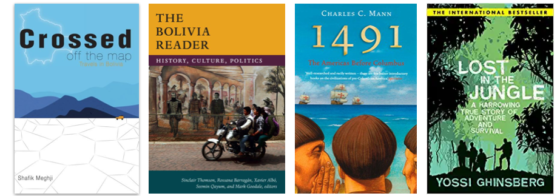
What are some of your recommended books about or set in Bolivia?
Shafik: One of the things, it’s a real shame the very few Bolivian authors are translated into English and beyond academic books, very few English language authors write about the country which is one of the reasons that I wrote Crossed Off the Map to help fill this in, but there are definitely a few other books that I would recommend.
The first one is The Bolivia Reader, which is Duke University Press, and it’s got several editors. It features an incredible range of extracts of writing about Bolivia, mainly from Bolivian authors. You have pieces by the former President Evo Morales, who was the first indigenous president in South America, but also by people like Che Guevara, who died in Bolivia. And also conquistadores like Pedro Cieza de León, who provides one of the earliest written accounts of Bolivia. So the book ranges from ancient stories and poetries, and legends, to fiction, and contemporary journalism. As I say, I particularly found it useful and interesting to read the early accounts from the 16th century.
One of the other books I’d recommend is 1491: The Americas Before Columbus, by Charles C. Mann, and that examines the indigenous societies across the Americas, including in what is now Bolivia, prior to the arrival of the Europeans. It was particularly interesting on the ancient cultures of the Llanos de Moxos, which is a part of the Bolivian Amazon. These ancient societies built thousands and thousands, tens of thousands of earthworks structures, including even pyramids in some of the most challenging environments imaginable. It’s an incredibly insightful book. And actually, it was a huge inspiration for Crossed Off the Map.
Also in the Bolivian Amazon, which is the reason that is often overlooked, so I always like to emphasize it is a book called Lost in the Jungle by a guy called Yossi Ghinsberg. People might be familiar with it because he was turned into a film a few years ago called ‘Jungle,’ with Daniel Radcliffe. It’s an adventurous tale of survival in the Bolivian Amazon.
Essentially, Yossi Ginsburg was a Israeli backpacker who went off on a expedition into the rainforest inevitably goes wrong, and he ends up lost and alone. But he survived. He went to great odds, despite being menaced by wild animals, not having any food, and so on. He was eventually rescued by indigenous communities, and wrote a very interesting and exciting book about it.
There’s also a coda to that book because it really helped to encourage interest in the Bolivian Amazon amongst backpackers. Initially, Israeli backpackers, but then, backpackers from the UK, Europe, and beyond. And it helped to turn a place called Rurrenabaque into a hub of eco-tourism. So it’s had an interest in afterlife, as well. But I think those three books will give you a bit of an insight into Bolivia’s history, and also its contemporary life.
Joanna: Brilliant. Where can people find you and your books online?
Shafik: Right, if you can spell up my name, I’m easy to find. It’s shafikmeghji.com. And then that’s the same for my twitter and Instagram handles and Crossed Off the Map: Travels in Bolivia is available from all good bookshops.
Joanna: Brilliant. Well, thanks so much for your time, Shafik. That was great.
Shafik: Oh, my absolute pleasure, Jo. Thanks for having me on.
The post Shaping The World In Profound And Unexpected Ways. Bolivia With Shafik Meghji appeared first on Books And Travel.
